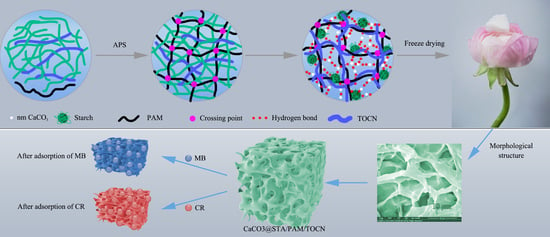Preparation of Bio-Based Aerogel and Its Adsorption Properties for Organic Dyes
Abstract
:1. Introduction
2. Results and Discussion
2.1. Characterization of Aerogels
2.2. Study of the Adsorption Properties of MB and CR
2.2.1. Effect of Solution pH
2.2.2. Effect of Contact Time
2.2.3. Influence of Ambient Temperature
2.2.4. Adsorption Kinetics, Isotherms, and Thermodynamics
2.2.5. Recycle Performance
2.2.6. Comparison of Aerogel Adsorption Performance
3. Conclusions
4. Materials and Methods
4.1. Materials
4.2. Analytical Measurements of MB and CR Concentration
4.3. Fabrication of the Aerogel
4.4. Characterization of Aerogel
4.5. Adsorption Kinetics
Author Contributions
Funding
Institutional Review Board Statement
Informed Consent Statement
Data Availability Statement
Acknowledgments
Conflicts of Interest
References
- Parale, V.G.; Kim, T.; Phadtare, V.D.; Han, W.; Lee, K.Y.; Jung, H.N.R.; Choi, H.; Kim, Y.; Yadav, H.M.; Park, H.H. SnO2 aerogel deposited onto polymer-derived carbon foam for environmental remediation. J. Mol. Liq. 2019, 287, 110990. [Google Scholar] [CrossRef]
- Zhao, J.; Li, B.Z.; Liu, Z.Y.; Dai, D.L.; Li, Y.Q.; Shi, R.H.; Zhang, H. A novel solar-triggered MIL-125(Ti)/g-C3N4/SA composite aerogel with high catalytic activity for degradation of organic contaminants. Sep. Purif. Technol. 2021, 279, 119696. [Google Scholar] [CrossRef]
- Hasan, M.; Gopakumar, D.A.; Arumughan, V.; Pottathara, Y.B.; Sisanth, K.S.; Pasquini, D.; Bracic, M.; Seantier, B.; Nzihou, A.; Thomas, S.; et al. Robust superhydrophobic cellulose nanofiber aerogel for multifunctional environmental applications. Polymers 2019, 11, 495. [Google Scholar]
- Zhu, Z.G.; Zhong, L.L.; Zhang, Z.Q.; Li, H.R.; Shi, W.X.; Cui, F.Y.; Wang, W. Gravity driven ultrafast removal of organic contaminants across catalytic superwetting membranes. J. Mater. Chem. A 2017, 5, 25266–25275. [Google Scholar] [CrossRef]
- Pourhakkak, P.; Taghizadeh, M.; Taghizadeh, A.; Ghaedi, M. Chapter 2—Adsorbent. Interface Sci. Technol. 2021, 33, 71–210. [Google Scholar]
- Li, X.B.; Yang, S.W.; Sun, J.; He, P.; Xu, X.G.; Ding, G.Q. Tungsten oxide nanowire-reduced graphene oxide aerogel for high-efficiency visible light photocatalysis. Carbon 2014, 78, 38–48. [Google Scholar] [CrossRef]
- Kalotra, S.; Mehta, R. Carbon aerogel and polyaniline/carbon aerogel adsorbents for Acid Green 25 dye: Synthesis, characterization and an adsorption study. Chem. Eng. Commun. 2022, 209, 757–773. [Google Scholar] [CrossRef]
- Li, W.; Sun, J.M.; Wu, Z.W.; Liu, S.X. N-doped carbon aerogels obtained from APMP fiber aerogels saturated with rhodamine dye and their application as supercapacitor electrodes. Appl. Sci. 2019, 9, 618. [Google Scholar]
- Wei, W.; Hu, H.H.; Yin, S.J.; Li, Y.X.; Ji, X.L.; Xie, J.M. Rational fabrication of chitosan/alginate/silica ternary aerogel beads adsorbent with free separation. Micro. Nano. Lett. 2019, 14, 142–145. [Google Scholar] [CrossRef]
- Ghaheh, F.S.; Taghizadeh, M.; Taghizadeh, A.; Hayati, B.; Mahmoodi, N.M.; Parastar, S. Clean synthesis of rock candy-like metal–organic framework biocomposite for toxic contaminants remediation. Environ. Technol. Inno. 2021, 23, 101747. [Google Scholar] [CrossRef]
- Zhao, M.K.; Zhang, S.F.; Fang, G.G.; Huang, C.; Wu, T. Directionally-grown carboxymethyl cellulose/reduced graphene oxide aerogel with excellent structure stability and adsorption capacity. Polymers 2020, 12, 2219. [Google Scholar] [CrossRef] [PubMed]
- Guo, X.; Huang, D.J.; Bai, W.X.; Zhao, H.; Ouyang, C.W.; Qiang, X.H.; Feng, L.B. A novel strategy to prepare chitosan/magnesite composite aerogel adsorbent: Magnesite as neutralizer and filler. Mater. Lett. 2022, 313, 131803. [Google Scholar] [CrossRef]
- Zeng, Z.H.; Ma, X.Y.D.; Zhang, Y.F.; Wang, Z.; Ng, B.F.; Wan, M.P.; Lu, X.H. Robust lignin-based aerogel filters: High-efficiency capture of ultrafine airborne particulates and the mechanism. Acs. Sustain. Chem. Eng. 2019, 7, 6959–6968. [Google Scholar] [CrossRef]
- Long, L.Y.; Weng, Y.X.; Wang, Y.Z. Cellulose aerogels: Synthesis, applications, and prospects. Polymers. 2018, 10, 623. [Google Scholar] [CrossRef] [Green Version]
- Ren, F.; Li, Z.; Tan, W.Z.; Liu, X.H.; Sun, Z.F.; Ren, P.G.; Yan, D.X. Facile preparation of 3D regenerated cellulose/graphene oxide composite aerogel with high-efficiency adsorption towards methylene blue. J. Colloid. Interf. Sci. 2018, 532, 58–67. [Google Scholar] [CrossRef] [PubMed]
- Song, W.Q.; Zhu, M.; Zhu, Y.F.; Zhao, Y.Z.; Yang, M.X.; Miao, Z.C.; Ren, H.P.; Ma, Q.; Qian, L.W. Zeolitic imidazolate framework-67 functionalized cellulose hybrid aerogel: An environmentally friendly candidate for dye removal. Cellulose 2020, 27, 2161–2172. [Google Scholar] [CrossRef]
- Gong, C.; Ni, J.P.; Tian, C.; Su, Z.H. Research in porous structure of cellulose aerogel made from cellulose nanofibrils. Int. J. Biol. Macromol. 2021, 172, 573–579. [Google Scholar] [CrossRef]
- Zheng, Q.Y.; Tian, Y.; Ye, F.Y.; Zhou, Y.; Zhao, G.H. Fabrication and application of starch-based aerogel: Technical strategies. Trends. Food. Sci. Tech. 2020, 99, 608–620. [Google Scholar] [CrossRef]
- Wang, Y.X.; Wu, K.; Xiao, M.; Riffat, S.B.; Su, Y.H.; Jiang, F.T. Thermal conductivity, structure and mechanical properties of konjac glucomannan/starch based aerogel strengthened by wheat straw. Carbohyd. Polym. 2018, 197, 284–291. [Google Scholar] [CrossRef]
- Guerra-Garces, J.; Garcia-Negrete, C.A.; Pastor-Sierra, K.; Arteaga, G.C.; Barrera-Vargas, M.; Jimenez de Haro, M.C.; Fernandez, A. Morphologically diverse CaCO3 microparticles and their incorporation into recycled cellulose for circular economy. Mater. Today. Sustain. 2022, 19, 100166. [Google Scholar] [CrossRef]
- Qin, Q.; Li, M.; Lan, P.; Liao, Y.X.; Sun, S.X.; Liu, H.Q. Novel CaCO3/chitin aerogel: Synthesis and adsorption performance toward Congo red in aqueous solutions. Int. J. Biol. Macromol. 2021, 181, 786–792. [Google Scholar] [CrossRef]
- Chong, K.Y.; Chia, C.H.; Zakaria, S.; Sajab, M.S. Vaterite calcium carbonate for the adsorption of Congo red from aqueous solutions. J. Environ. Chem. Eng. 2014, 2, 2156–2161. [Google Scholar] [CrossRef]
- Chong, K.Y.; Chia, C.H.; Zakaria, S.; Sajab, M.S.; Chook, S.W.; Khiew, P.S. CaCO3-decorated cellulose aerogel for removal of Congo Red from aqueous solution. Cellulose 2015, 22, 2683–2691. [Google Scholar] [CrossRef]
- He, T.; Tong, G.; Li, P.H.; Miao, C.; Zhang, X.; Xu, X.W. Effect of nano precipitated calcium carbonate on the properties of hydrogels prepared with acrylamide, starch, and TEMPO-oxidized nanocellulose. Bioresources 2022, 17, 5079–5094. [Google Scholar] [CrossRef]
- Kuusisto, J.; Maloney, T.C. Preparation and characterization of corn starch-calcium carbonate hybrid pigments. Ind. Crop. Prod. 2016, 83, 294–300. [Google Scholar] [CrossRef]
- Nia, M.H.; Tavakolian, M.; Kiasat, A.R.; van de Ven, T.G.M. Hybrid aerogel nanocomposite of dendritic colloidal silica and hairy nanocellulose: An effective dye adsorbent. Langmuir 2020, 36, 11963–11974. [Google Scholar] [CrossRef] [PubMed]
- Wei, X.; Huang, T.; Nie, J.; Yang, J.H.; Qi, X.D.; Zhou, Z.W.; Wang, Y. Bio-inspired functionalization of microcrystalline cellulose aerogel with high adsorption performance toward dyes. Carbohyd. Polym. 2018, 198, 546–555. [Google Scholar] [CrossRef]
- Shaheed, N.; Javanshir, S.; Dekamin, M.G.; Naimi-Jamal, M.R. Synthesis of nanocellulose aerogels and Cu-BTC/nanocellulose aerogel composites for adsorption of organic dyes and heavy metal ions. Sci. Rep. 2021, 11, 18553. [Google Scholar] [CrossRef]
- Qiu, C.P.; Tang, Q.; Zhang, X.L.; Li, M.C.; Zhang, X.F.; Xie, J.L.; Zhang, S.B.; Su, Z.P.; Qi, J.Q.; Xiao, H. High-efficient double-cross-linked biohybrid aerogel biosorbent prepared from waste bamboo paper and chitosan for wastewater purification. J. Clean. Prod. 2022, 338, 130550. [Google Scholar] [CrossRef]
- Jiang, J.X.; Zhang, Q.H.; Zhan, X.L.; Chen, F.Q. A multifunctional gelatin-based aerogel with superior pollutants adsorption, oil/water separation and photocatalytic properties. Chem. Eng. J. 2019, 358, 1539–1551. [Google Scholar] [CrossRef]
- Tan, M.H.; Zheng, S.M.; Lv, H.N.; Wang, B.; Zhao, Q.S.; Zhao, B. Rational design and synthesis of chitosan–quinoa polysaccharide composite aerogel and its adsorption properties for Congo red and methylene blue. New. J. Chem. 2021, 45, 9829–9837. [Google Scholar] [CrossRef]
- Jiao, C.L.; Li, T.T.; Wang, J.; Wang, H.; Zhang, X.L.; Han, X.J.; Du, Z.F.; Shang, Y.L.; Chen, Y.Y. Efficient removal of dyes from aqueous solution by a porous sodium alginate/gelatin/graphene oxide triple-network composite aerogel. J. Polym. Environ. 2020, 28, 1492–1502. [Google Scholar] [CrossRef]
- Arabkhani, P.; Asfaram, A. Development of a novel three-dimensional magnetic polymer aerogel as an efficient adsorbent for malachite green removal. J. Hazard. Mater. 2020, 384, 121394. [Google Scholar] [CrossRef] [PubMed]
- Tarashi, S.; Nazockdast, H.; Shafaghsorkh, S.; Sodeifian, G. A porous monolith polysaccharide-based adsorbent aerogel with enhanced mechanical performance and efficient adsorption capacity. Sep. Purif. Technol. 2022, 287, 120587. [Google Scholar] [CrossRef]
- Zhang, T.J.; Xiao, S.Y.; Fan, K.H.; He, H.; Qin, Z.Y. Preparation and adsorption properties of green cellulose-based composite aerogel with selective adsorption of methylene blue. Polymer 2022, 258, 125320. [Google Scholar] [CrossRef]
- Xiao, J.L.; Lv, W.Y.; Xie, Z.; Song, Y.H.; Zheng, Q. L-cysteine-reduced graphene oxide/poly(vinyl alcohol) ultralight aerogel as a broad-spectrum adsorbent for anionic and cationic dyes. J. Mater. Sci. 2017, 52, 5807–5821. [Google Scholar] [CrossRef]
- Tang, S.; Xia, D.S.; Yao, Y.; Chen, T.Y.; Sun, J.; Yin, Y.J.; Shen, W.; Peng, Y.X. Dye adsorption by self-recoverable, adjustable amphiphilic graphene aerogel. J. Colloid. Interf. Sci. 2019, 554, 682–691. [Google Scholar] [CrossRef]
- Huang, T.; Shao, Y.W.; Zhang, Q.; Deng, Y.F.; Liang, Z.X.; Guo, F.Z.; Li, P.C.; Wang, Y. Chitosan-cross-linked graphene oxide/carboxymethyl cellulose aerogel globules with high structure stability in liquid and extremely high adsorption ability. Acs. Sustain. Chem. Eng. 2019, 7, 8775–8788. [Google Scholar] [CrossRef]
- Wang, S.J.; Zhang, Q.Q.; Wang, Z.X.; Pu, J.W. Facile fabrication of an effective nanocellulose-based aerogel and removal of methylene blue from aqueous system. J. Water. Process. Eng. 2020, 37, 101511. [Google Scholar] [CrossRef]
- Li, K.D.; Lei, Y.Q.; Liao, J.; Zhang, Y. A facile synthesis of graphene oxide/locust bean gum hybrid aerogel for water purification. Carbohyd. Polym. 2021, 254, 117318. [Google Scholar] [CrossRef]
- He, Z.C.; Wu, F.; Guan, S.J.; Liu, L.; Li, J.; Huang, Y.D. Polyamide amine/aramid nanofiber composite aerogels as an ultra-high capacity adsorbent for Congo red removal. J. Mater. Chem. A 2021, 9, 13320–13331. [Google Scholar] [CrossRef]
- Han, H.K.; Wei, W.; Jiang, Z.F.; Lu, J.W.; Zhu, J.J.; Xie, J.M. Removal of cationic dyes from aqueous solution by adsorption onto hydrophobic/hydrophilic silica aerogel. Colloid. Surface. A 2016, 509, 539–549. [Google Scholar] [CrossRef]
- Lei, C.Y.; Wen, F.B.; Chen, J.M.; Chen, W.L.; Huang, Y.W.; Wang, B. Mussel-inspired synthesis of magnetic carboxymethyl chitosan aerogel for removal cationic and anionic dyes from aqueous solution. Polymer 2021, 213, 123316. [Google Scholar] [CrossRef]
- Liu, Y.Y.; Ke, Y.L.; Shang, Q.G.; Yang, X.F.; Wang, D.S.; Liao, G.Y. Fabrication of multifunctional biomass-based aerogel with 3D hierarchical porous structure from waste reed for the synergetic adsorption of dyes and heavy metal ions. Chem. Eng. J. 2022, 451, 138934. [Google Scholar] [CrossRef]
- Wang, X.Y.; Xie, P.B.; He, L.; Liang, Y.W.; Zhang, L.; Miao, Y.Y.; Liu, Z.B. Ultralight, mechanically enhanced, and thermally improved graphene-cellulose-polyethyleneimine aerogels for the adsorption of anionic and cationic dyes. Nanomaterials 2022, 12, 1727. [Google Scholar] [CrossRef]
- Jiang, F.; Dinh, D.M.; Hsieh, Y.L. Adsorption and desorption of cationic malachite green dye on cellulose nanofibril aerogels. Arbohyd. Polym. 2017, 173, 286–294. [Google Scholar] [CrossRef] [Green Version]
- Tang, M.Z.; Jia, R.L.; Kan, H.Y.; Liu, Z.L.; Yang, S.X.; Sun, L.L.; Yang, Y.W. Kinetic, isotherm, and thermodynamic studies of the adsorption of dye from aqueous solution by propylene glycol adipate-modified cellulose aerogel. Colloid. Surface. A 2020, 602, 125009. [Google Scholar] [CrossRef]
- Grishkewich, N.; Li, Y.Z.; Liu, K.; Tam, K.C. Synthesis and characterization of modified cellulose nanofibril organosilica aerogels for the removal of anionic dye. J. Polym. Res. 2022, 29, 261. [Google Scholar] [CrossRef]
- Esmaeili, Z.; Izadyar, S.; Hamzeh, Y.; Abdulkhani, A. Preparation and characterization of highly porous cellulose nanofibrils/chitosan aerogel for acid blue 93 adsorption: Kinetics, isotherms, and thermodynamics analysis. J. Chem. Eng. Data. 2021, 66, 1068–1080. [Google Scholar] [CrossRef]
- Lv, Y.; Xing, B.L.; Zheng, M.K.; Yi, G.Y.; Huang, G.X.; Zhang, C.X.; Yuan, R.F.; Chen, Z.F.; Cao, Y.J. Hydrothermal synthesis of ultra-light coal-based graphene oxide aerogel for efficient removal of dyes from aqueous solutions. Nanomaterials 2018, 8, 670. [Google Scholar] [CrossRef] [Green Version]
- Song, G.B.; Shi, Y.W.; Li, A.Q.; Wang, H.N.; Ding, G.H. Facile preparation of three-dimensional graphene oxide/iota-carrageenan composite aerogel and its efficient ability for selective adsorption of methylene blue. J. Mater. Sci. 2021, 56, 14866–14879. [Google Scholar] [CrossRef]
- Maatar, W.; Boufi, S. Microporous cationic nanofibrillar cellulose aerogel as promising adsorbent of acid dyes. Cellulose 2017, 24, 1001–1015. [Google Scholar] [CrossRef]
- Druzian, S.P.; Zanatta, N.P.; Borchardt, R.K.; Cortes, L.N.; Streit, A.F.M.; Severo, E.C.; Goncalves, J.O.; Foletto, E.L.; Lima, E.C.; Dotto, G.L. Chitin-psyllium based aerogel for the efficient removal of crystal violet from aqueous solutions. Int. J. Biol. Macromol. 2021, 179, 366–376. [Google Scholar] [CrossRef]
- Zhu, W.; Jiang, X.L.; Jiang, K.; Liu, F.J.; You, F.; Yao, C. Fabrication of reusable carboxymethyl cellulose/graphene oxide composite aerogel with large surface area for adsorption of methylene blue. Nanomaterials 2021, 11, 1609. [Google Scholar] [CrossRef] [PubMed]
- Vu, P.V.; Doan, T.D.; Tu, G.C.; Do, N.H.N.; Le, K.A.; Le, P.K. A novel application of cellulose aerogel composites from pineapple leaf fibers and cotton waste: Removal of dyes and oil in wastewater. J. Porous. Mat. 2022, 29, 1137–1147. [Google Scholar] [CrossRef]
- Mahmoodi, N.M.; Mokhtari-Shourijeh, Z.; Langari, S.; Naeimi, A.; Hayati, B.; Jalili, M.; Seifpanahi-Shabani, K. Silica aerogel/polyacrylonitrile/polyvinylidene fluoride nanofiber and its ability for treatment of colored wastewater. J. Mol. Struct. 2021, 1227, 129418. [Google Scholar] [CrossRef]
- Yang, L.; Zhan, Y.F.; Gong, Y.J.; Ren, E.H.; Lan, J.W.; Guo, R.H.; Yan, B.; Chen, S.; Lin, S.J. Development of eco-friendly CO2-responsive cellulose nanofibril aerogels as “green” adsorbents for anionic dyes removal. J. Hazard. Mater. 2021, 405, 124194. [Google Scholar] [CrossRef]
- Xie, Q.; Zou, Y.K.; Wang, Y.Z.; Wang, H.B.; Du, Z.L.; Cheng, X. Mechanically robust sodium alginate/cellulose nanofibers/polyethyleneimine composite aerogel for effective removal of hexavalent chromium and anionic dyes. Polym. Eng. Sci. 2022, 62, 1927–1940. [Google Scholar] [CrossRef]
- Huo, Y.; Liu, Y.Y.; Yang, J.; Du, H.; Qin, C.R.; Liu, H.B. Polydopamine-modified cellulose nanofibril composite aerogel: An effective dye adsorbent polydopamine-modified cellulose nanofibril composite aerogel: An effective dye adsorbent. Langmuir 2022, 38, 4164–4174. [Google Scholar] [CrossRef]
- Yang, Q.X.; Lu, R.; Ren, S.S.; Chen, C.T.; Chen, Z.J.; Yang, X.Y. Three dimensional reduced graphene oxide/ZIF-67 aerogel: Effective removal cationic and anionic dyes from water. Chem. Eng. J. 2018, 348, 202–211. [Google Scholar] [CrossRef]
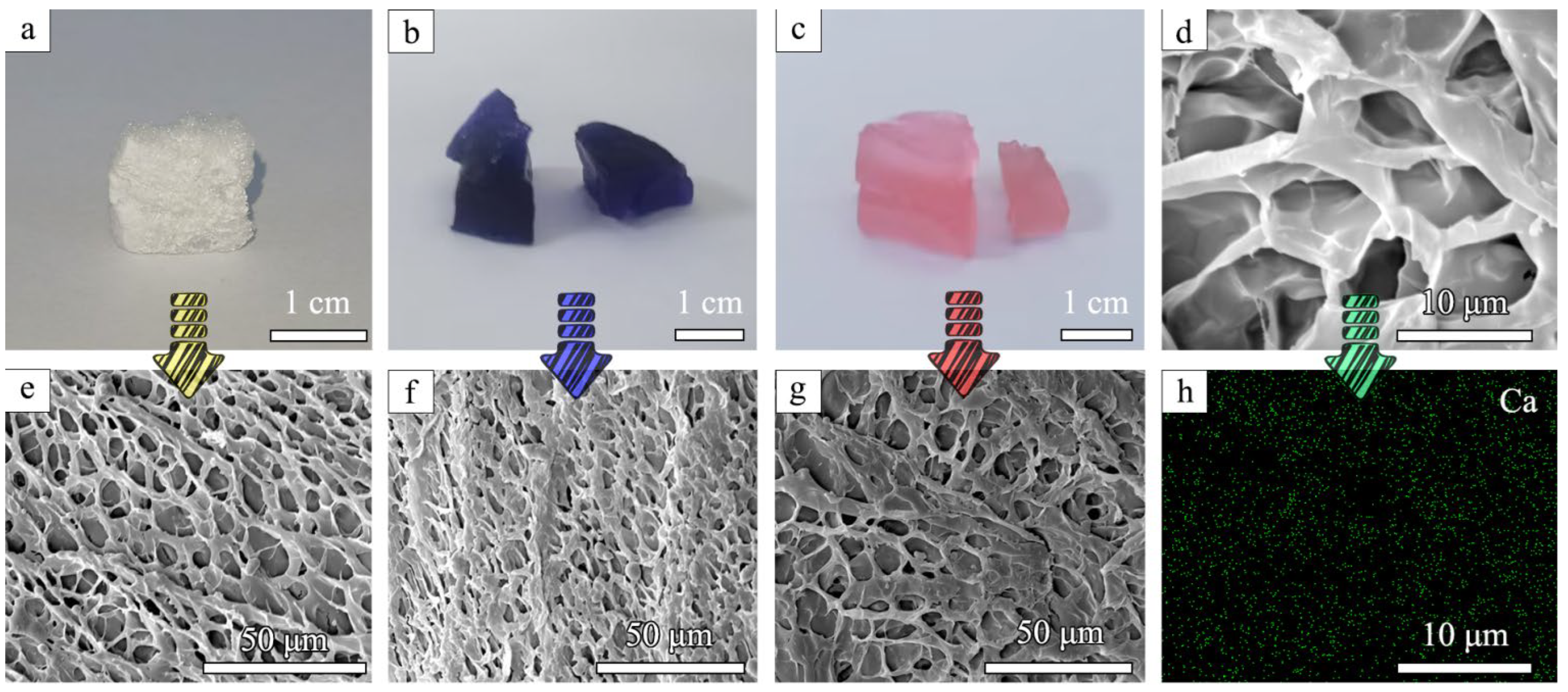


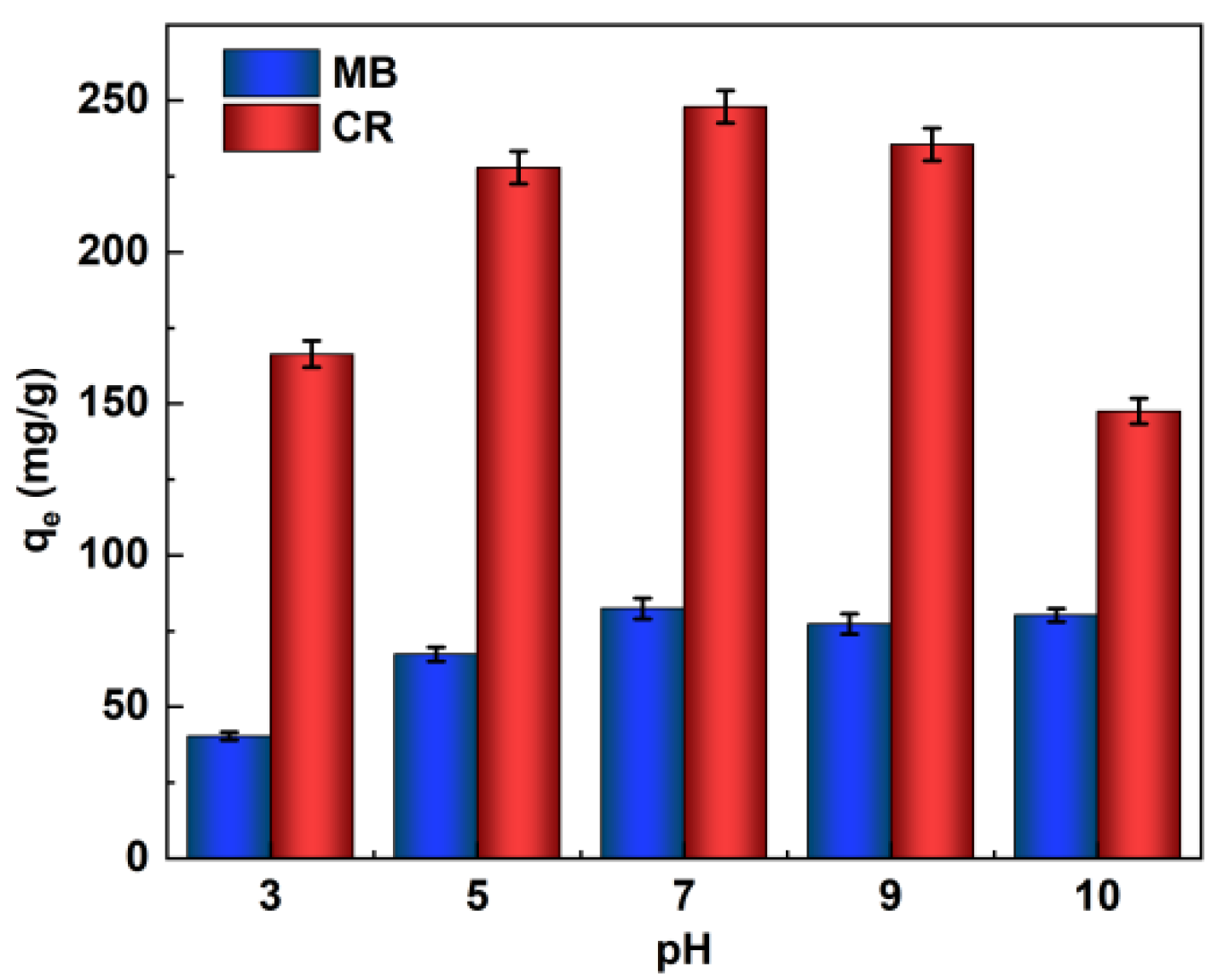
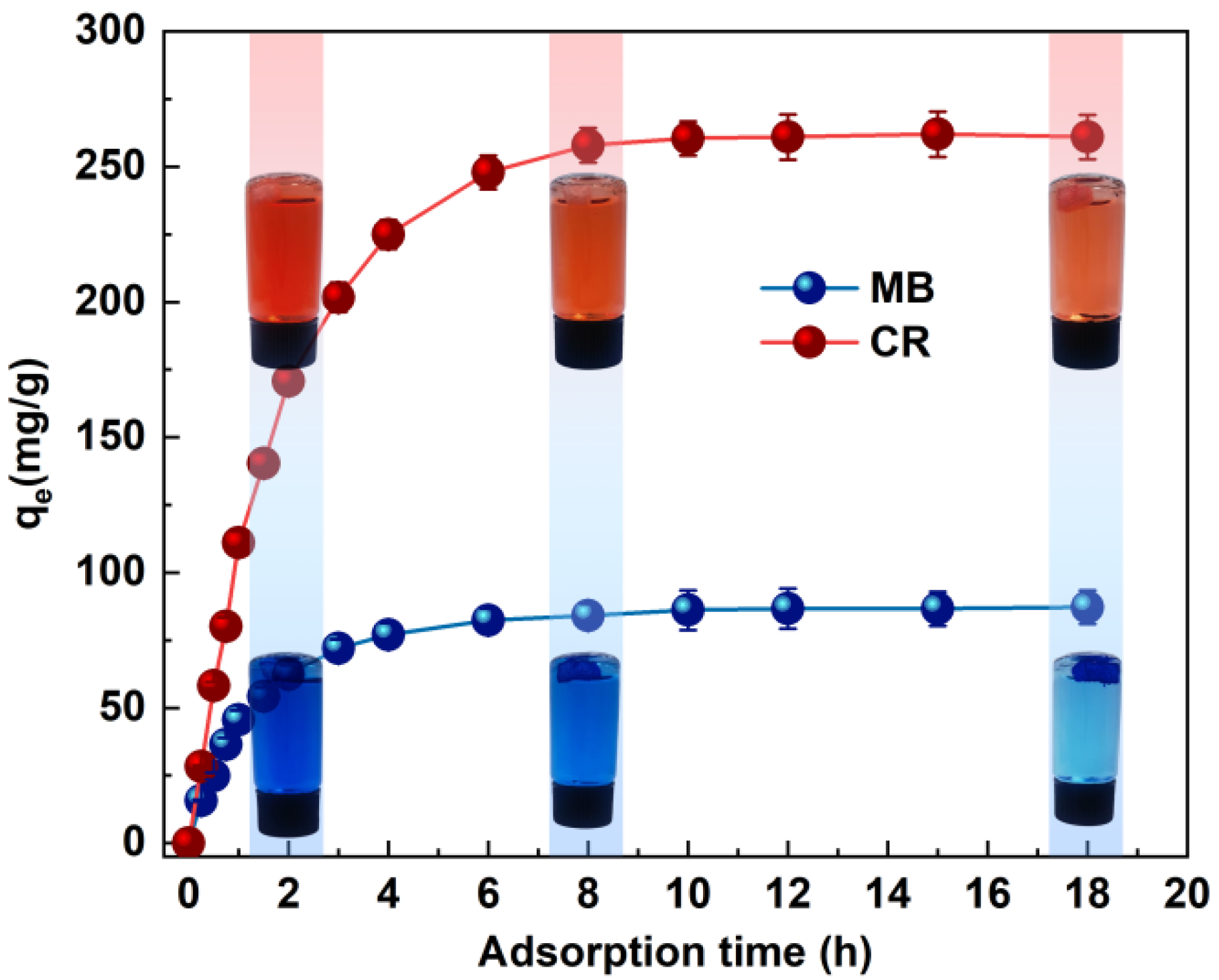

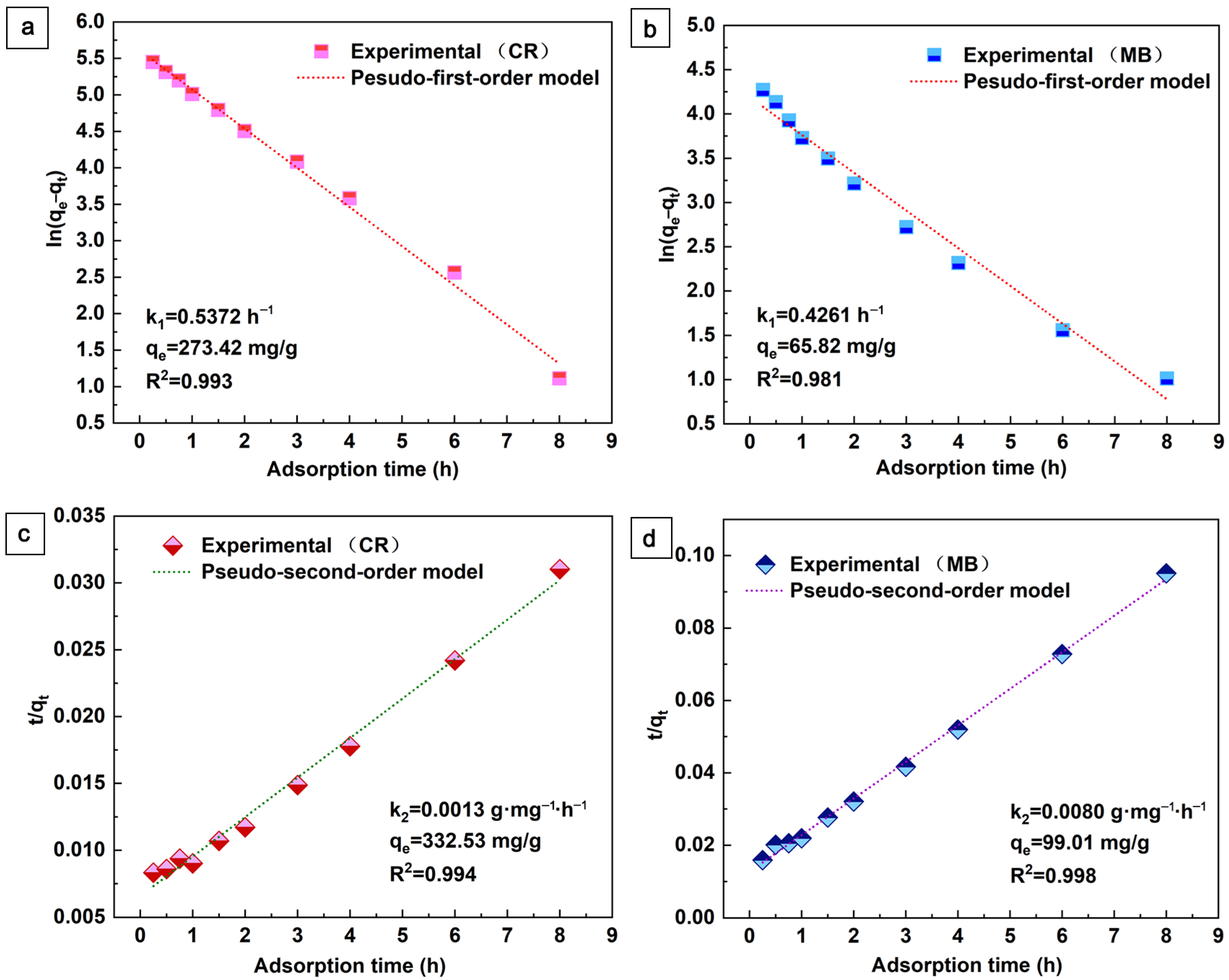

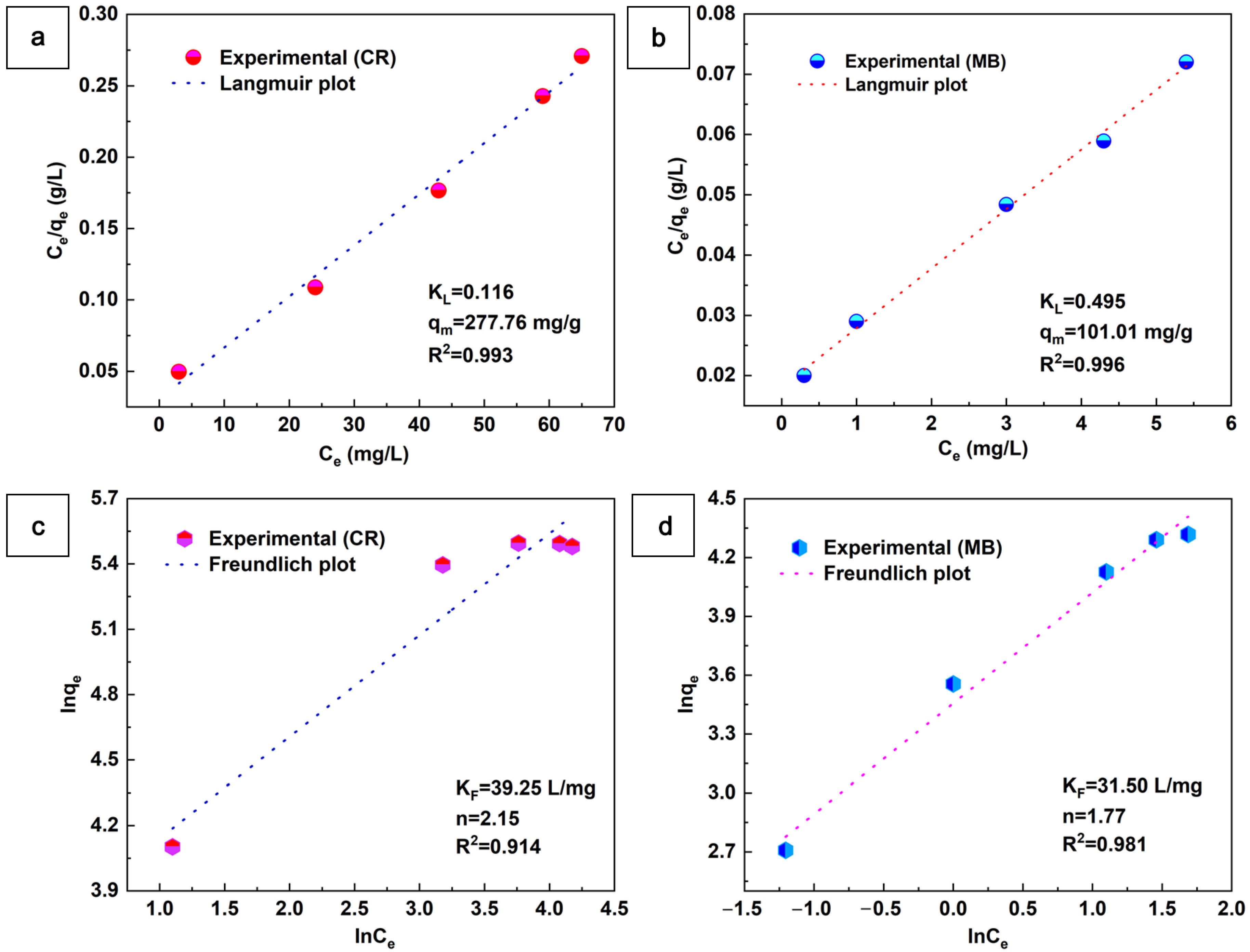
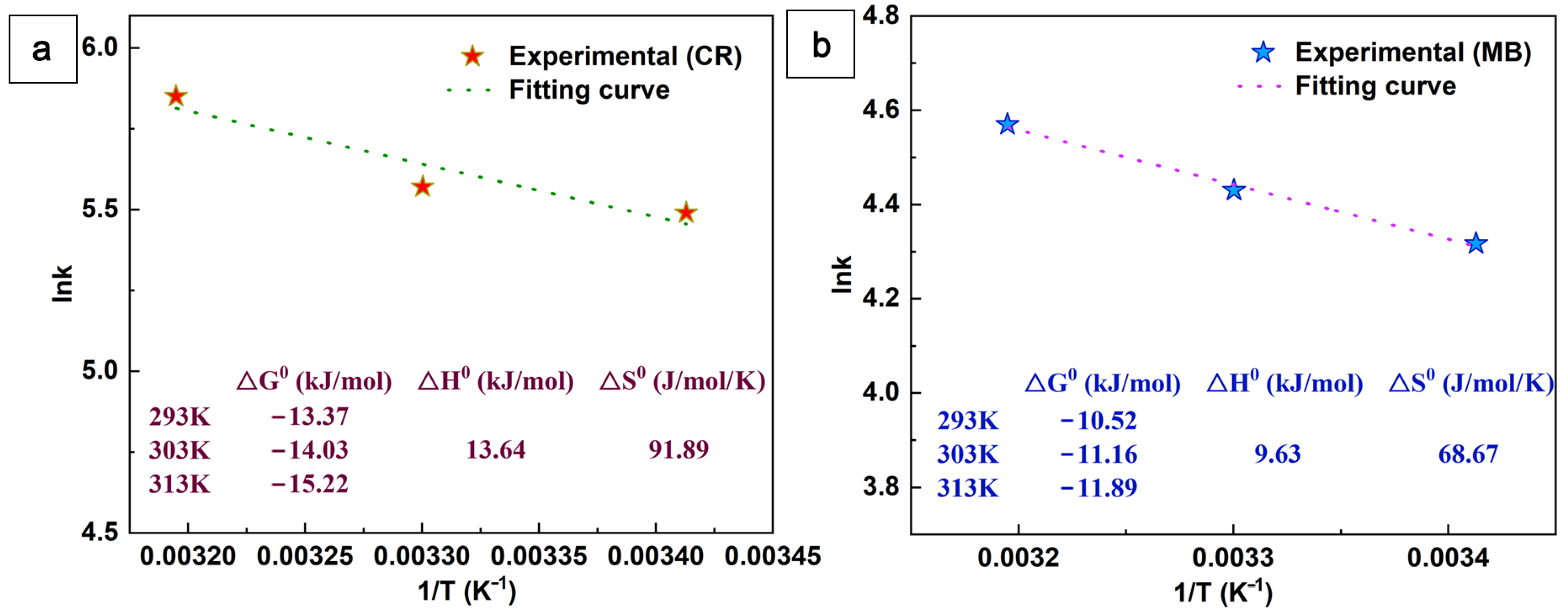

| Adsorbents | Dyes | Adsorption Capacity (mg/g) | Reference |
|---|---|---|---|
| Fe3O4@polydopamine/carboxymethyl chitosan aerogel | MB | 217.4 | [43] |
| CV | 262.3 | ||
| MO | 83.5 | ||
| CR | 92.8 | ||
| Cellulose/chitosan aerogel | CR | 380.2 | [44] |
| Graphene-cellulose-polyethyleneimine aerogel | Amaranth | 369.4 | [45] |
| MB | 237.3 | ||
| Cellulose nanofibrils aerogel | MG | 203.7 | [46] |
| Poly(propylene glycol adipate)-modified cellulose aerogel | CR | 120 | [47] |
| Cellulose nanofibrils and (3-mercaptopropyl) trimethoxysilane compressible aerogels | MO | 186.7 | [48] |
| Chitosan and cellulose nanofibrils aerogel | AB93 | 1428.7 | [49] |
| Carboxymethyl cellulose-supported graphene oxide aerogel | rhodamine B | 312.5 | [50] |
| 3D graphene oxide/ι-carrageenan composite aerogel | MB | 245.3 | [51] |
| Cationic cellulose nanofibrils aerogel | Blue dye CR19 | 230 | [52] |
| Red dye 180 | 160 | ||
| Orange dye 142 | 560 | ||
| Chitin and psyllium biopolymers aerogel | CV | 227.1 | [53] |
| Carboxymethyl cellulose and graphene oxide composite aerogel | MB | 245.0 | [54] |
| Pineapple leaf fibers and cotton waste cellulose aerogel | MB | 34.0 g/g | [55] |
| Silica aerogel/polyacrylonitrile/polyvinylidene fluoride nanofiber | BR18 | 182 | [56] |
| Poly(methacrylic acid-co-2-(dimethylamino) ethyl methacrylate) and carboxylated cellulose nanofibrils aerogel | MB | 598.8 | [57] |
| NGB | 621.1 | ||
| MO | 892.9 | ||
| Sodium alginate/cellulose nanofibers/polyethyleneimine composite aerogel | CR | 2007.5 | [58] |
| MO | 2253.4 | ||
| Polydopamine-Modified Cellulose Nanofibril Composite Aerogel | MB | 208 | [59] |
| 3D rGO/ZIF-67 aerogel | CV | 1714.2 | [60] |
| CaCO3@STA/PAM/TOCN aerogel | CR | 277.76 | This work |
| MB | 101.01 |
| Dyes | Congo Red | Methylene Blue |
|---|---|---|
| Molecular formula | C32H22N6Na2O6S2 | CHN3ClS |
| Molecular weight | 696.68 g/mol | 319.85 g/mol |
| Structural | 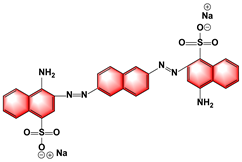 |  |
| Type of dye | Anionic dye | Cationic dye |
| Maximum absorption wavelength/nm | 499 | 664 |
| Standard curve | 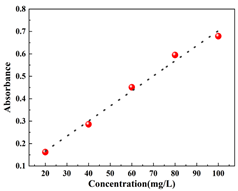 |  |
| Standard curve equation | y = 0.0067 x + 0.0317 | y = 0.2215 x − 0.0602 |
| Correlation coefficient (R2) | 0.987 | 0.998 |
Publisher’s Note: MDPI stays neutral with regard to jurisdictional claims in published maps and institutional affiliations. |
© 2022 by the authors. Licensee MDPI, Basel, Switzerland. This article is an open access article distributed under the terms and conditions of the Creative Commons Attribution (CC BY) license (https://creativecommons.org/licenses/by/4.0/).
Share and Cite
Li, P.; Yang, C.; Xu, X.; Miao, C.; He, T.; Jiang, B.; Wu, W. Preparation of Bio-Based Aerogel and Its Adsorption Properties for Organic Dyes. Gels 2022, 8, 755. https://doi.org/10.3390/gels8110755
Li P, Yang C, Xu X, Miao C, He T, Jiang B, Wu W. Preparation of Bio-Based Aerogel and Its Adsorption Properties for Organic Dyes. Gels. 2022; 8(11):755. https://doi.org/10.3390/gels8110755
Chicago/Turabian StyleLi, Penghui, Chi Yang, Xuewen Xu, Chen Miao, Tianjiao He, Bo Jiang, and Wenjuan Wu. 2022. "Preparation of Bio-Based Aerogel and Its Adsorption Properties for Organic Dyes" Gels 8, no. 11: 755. https://doi.org/10.3390/gels8110755
APA StyleLi, P., Yang, C., Xu, X., Miao, C., He, T., Jiang, B., & Wu, W. (2022). Preparation of Bio-Based Aerogel and Its Adsorption Properties for Organic Dyes. Gels, 8(11), 755. https://doi.org/10.3390/gels8110755







